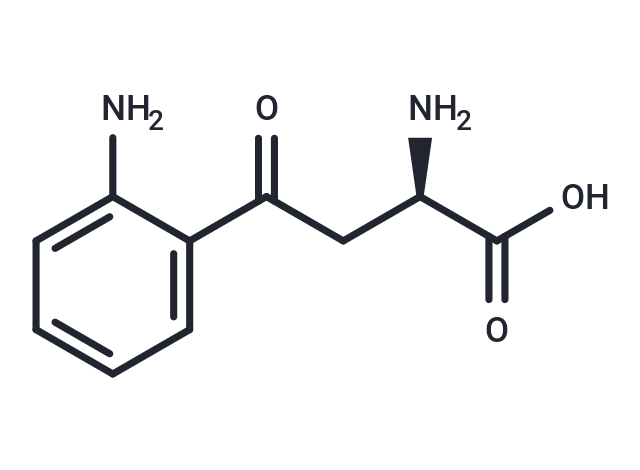Shopping Cart
- Remove All

Your shopping cart is currently empty


| Pack Size | Price | Availability | Quantity |
|---|---|---|---|
| 25 mg | $48 | In Stock | |
| 50 mg | $82 | In Stock | |
| 100 mg | $132 | In Stock | |
| 200 mg | $195 | In Stock |
| Description | D-Kynurenine (ZINC901103) is a metabolite of D-tryptophan and an agonist of GPR109B. D-Kynurenine activates AhR and promotes the conversion of the epithelium to mesenchyme. D-Kynurenine serves as a substrate in the fluorescence analysis of D-amino acid oxidase. |
| In vitro | D-Kynurenine (10-100 µM) induces DER-enhancement and positively regulates the transfer of 95D cells, which is attenuated after siRNAAhr treatment in VIM and E-cadherin. D-Kynurenine (10 and 40 µM) significantly increases VIM expression and induces CYP1A1 upregulation. D-Kynurenine (10 µM) significantly attenuates the level of E-cadherin[4]. |
| Alias | (R)-2-Amino-4-(2-aminophenyl)-4-oxobutanoic acid, ZINC901103 |
| Molecular Weight | 208.21 |
| Formula | C10H12N2O3 |
| Cas No. | 13441-51-5 |
| Storage | Powder: -20°C for 3 years | In solvent: -80°C for 1 year | Shipping with blue ice. | |||||||||||||||||||||||||
| Solubility Information | H2O: 5 mg/mL (24.01 mM), Sonication and heating to 60℃ are recommended. | |||||||||||||||||||||||||
Solution Preparation Table | ||||||||||||||||||||||||||
H2O
| ||||||||||||||||||||||||||

Copyright © 2015-2024 TargetMol Chemicals Inc. All Rights Reserved.